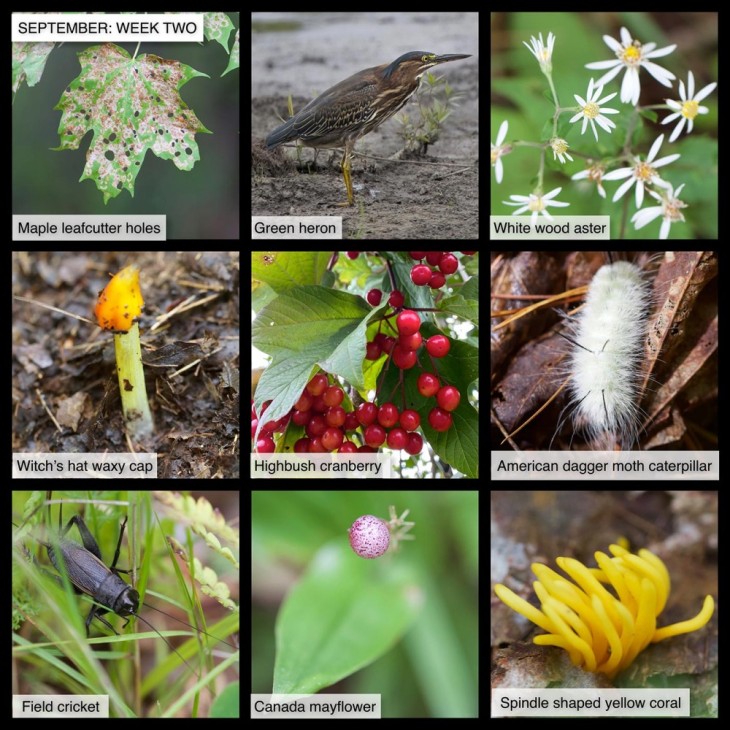This Week in the Woods, we’ve been noticing the circular holes and brown, ring-shaped feeding patches created by maple leafcutter moth larvae. This insect has a clever way to hide from birds and other predators. It cuts discs out of its food leaf and binds these together to form a two-sided feeding shelter. Most of the worm stays hidden in the shelter, with only its front end emerging as it grazes on the surrounding leaf surface. At the end of summer, the worm drops to the forest floor, where it pupates. Here’s an Outside Story essay by Bryan Pfeiffer describing the insect’s larval career, and here’s a close-up photo from bugguide.net that shows what it looks like when it’s tucked into its tent with its head poking out. As Pfeiffer observes, “It’s a bit like a pita bread with a caterpillar inside, or, better yet, a turtle with two shells.”
Green herons are smaller and (at a distance) less spectacular than their great blue cousins, but they’re fascinating birds. As Todd McLeish notes in this Outside Story essay, the green heron is one of the only North American birds known to use tools: “[It] will use objects – twigs, feathers, crusts of bread – to lure fish within reach.” Although this year’s young have fledged, you can still see them hanging around with their parents, practicing their hunting skills; we’ve repeatedly seen two green herons hunting together in a wetland.
White wood aster is blooming now and is common along trails. Unlike many asters, it grows well in the shade. Asters and goldenrods are some our latest-blooming flowers and are mainstays for late-season butterflies and other insects. Their seeds are also valuable as food for winter wildlife. Here’s an Outside Story essay about asters by Joe Rankin.
We’ve found a number of different (and hard to conclusively identify) species of waxy cap mushrooms (genus Hygrocybe) this week. Many of them are intense shades of red, orange and yellow. Both caps and gills have a waxy look and texture. One of the easiest to identify is witch’s hat, which grows just a few inches high, and has a steeply pitched cap (multiple colors) and dark vertical lines on its stem. For a beautiful photo of scarlet waxy caps by Nate Rosebrooks, check out last September’s Northern Woodlands Reader Photo Gallery.
Highbush cranberry is ripening. As noted in this University of Maine Extension profile, the plant is a member of the viburnum family – it’s not a true cranberry, but a woody shrub. For a great overview of wild berries that serve as important wildlife food from now through winter, see this 2014 Northern Woodlands article by Susan Morse: “Soft Serve: Autumn’s Unheralded Mast Species.” Citing Bernd Heinrich’s observations in his book Winter World, Morse notes that highbush cranberries often go untouched this time of year, but that birds eat them in winter.
The American dagger moth caterpillar, which can be either white or yellow, is cute, fuzzy, and has long black bristles that can deliver a sting, and painful rash. It’s common this time of year, and because it can feed on the leaves of so many trees and shrubs, it often shows up in backyards. David Wagner, in Caterpillars of Eastern North America (a must-have book for the caterpillar curious), notes its practice of excavating wood to build its pupal chamber, and relates how he found one chamber of “what I believe was a dagger caterpillar…in the cedar siding of my home. It gnawed a trench some 3 cm in length.”
Despite their name, fall field crickets have a tendency to abandon fields for the dark crannies of homes, where they chirp. All. Night. Long. This profile in the Vermont Center for Ecostudies’ Vermont Atlas of Life explains why: “They are not tolerant to frost and cold so as winter approaches they are attracted to the heat in homes and other buildings and often make their way inside.” For a close look at how male crickets chirp, check out this great video from KQED San Francisco, which shows how they rake together the files (line of microscopic teeth) and scrapers on their wings to woo mates, and warn off rivals. Also, to learn how scientists study tree crickets by mapping sound, check out this article by editor Cheryl Daigle from the autumn 2020 issue of Northern Woodlands magazine.
Canada mayflowers are a common and easy to identify plant of the forest floor, with glossy green leaves, spires of white flowers in spring, and bright red berries in late summer to early fall. Some references describe the plant as having limited wildlife value, but in our observation the berries get gobbled up quickly, and this Native Plant Trust profile describes them as “valuable to birds.” This past week, we’ve see several of these berries in their ripening stage: pink with red speckles.
Spindle shaped yellow coral is also growing in profusion this week, most often around seeps and along (now dry) vernal pools. Older specimens have darkened tips, which gives them a singed appearance. As Timothy J. Baroni notes in his book Mushrooms of the United States and Canada, “This brightly yellow clustered coral is very common and difficult to miss in the woods.”
In this difficult period, many of us find joy in observing local nature, and many families are seeking outdoor enrichment opportunities for children. Here are nine photographs taken this past week, most within 15 miles of the Northern Woodlands office in Lyme, New Hampshire. We hope you enjoy using this grid as a prompt for your own explorations, or as the basis for a game of family forest tic-tac-toe.
What are you seeing in the woods this week? Share your images with us on Facebook, or submit a special photo for possible inclusion in our monthly online Reader Photo Gallery.



Discussion *